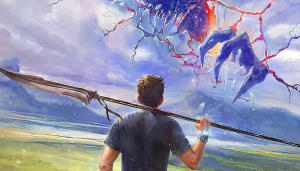Often referred to as “The Soviet Walt Disney”, I’ve gotten to the point of preferring the opposite designation – Walt Disney is “The American Aleksandr Ptushko”. Ptushko came later of course, beginning as an animator with The Missing Certificate (1927) and eventually becoming one of the Soviet Unions and later the world’s most imaginative auteurs with the release of the landmark historical fantasy film Ilya Muromets in 1956. Like the several other historical fantasies that came after it, Ilya Muromets’ reputation was sullied in the United States because its transfer was cut (read – butchered) to fit more to the tastes of Hollywood-going audiences. It was one of Roger Corman’s rare sins and surprising considering he was such a champion of world cinema. Ptushko is probably today most known through Mystery Science Theater 3000s various riffs on his work, deemed ‘campy, trashy, artificial’ and the like. But the recent 4K restorations of his movies under Deaf Crocodile have revitalized these stunning colorful Cinemascope masterpieces for new audiences and show them in their original cuts. After writing long on his masterpiece Ilya Muromets, I have more words here to say about Ptushko’s follow-up Sampo (1959) and his final film, Ruslan & Ludmila (1972).
Sampo (1959)
His only movie to be a co-production between the Soviet Union and Finland, and also his only film in Finnish, Sampo tells the tale of a blacksmith named Ilmarinen (Ivan Voronov) in the town of Kalevala who has the magical ability to summon a “Sampo”, a mystical good-fortune mill that supplies endless grain and gold for whoever possesses it. When his sister Annikki (Eve Kivi) falls in love with a young man named Lemminkäinen (Andris Ošinš), the witch Louhi from the dark island of Pohloj summons Annikki and traps her in a cave in order to lure Ilmarinen. She tells him, in exchange for his sister, he must do various chores including summon the Sampo so her island will be rich.
The film’s color pallet is one of Ptushko’s most starkly bold but also focused on mainly just two colors – glowing red and ice-cold blue hues that shimmer and reflect light. It may be a cliché to use “painterly” as a descriptor for beautiful imagery in film, but so much within the frame in Ptushko’s films is quite literally hand-crafted, either sculpted or painted and every single inch of his canvass could hang in a museum as a representation of medieval Slavic art. His penchant for overlaying textures onto the canvass act as special effects. When the Sampo is finally created we see a kaleidoscopic rainbow light glimmer from it, overlaid on the flat, dark blue painted landscape of the island. The black cloak that Louhi uses to lure Annikki to the island floats across the sea and attaches to the mast of her boat. It’s this sort of magical use of practical effects and visual trickery that make Ptushko’s films feel really imaginative and in the direct lineage of great visual masterpieces like Le voyage dans la lune or Metropolis or The Thief of Baghdad.
Ruslan & Ludmila (1972)
Ruslan & Ludmila, Ptushko’s final film and released just months before his passing, is a worthy swansong that delivers on the master filmmaker’s exquisite ability to create dazzling fantasy sets, dramedy theatrics between characters, and rousing war battles. Based on an epic poem by Alexander Pushkin, it tells the story of a young knight Ruslan (Valeri Kozinets) who is chosen to be the husband of the Prince Vladimir’s (Andrei Abrikosov) daughter Ludmila (Natalya Petrova). After Ludmila is kidnapped by the magical powers of a dwarf sorcerer named Chernomor (Vladimir Fyodorov), the Prince renounces Ruslan’s attempts at marriage and says anyone who rescues his daughter will be her husband. Three other men step up to rescue but Ruslan must do so before them to win her back.
Ptushko’s canvas is lush with rainbow colors, his sets of Chernomor’s layers are some of the most fantastical and hypnotizing in all of cinema, layering crystalline figures and statues atop each other and having the rainbow light reflecting off of them and through multiple prisms creates a near infinite glowing canvas that his characters can dance and fight around in. Similar to Michael Powell and Emeric Pressburger’s latter fantasies like Tales of Hoffman, Ptushko’s final film doesn’t rush the story that builds its frame. His final statement as a filmmaker seems to prefer the fantastical over the practical even in a cinematic sense. Instead there are intricate dance sequences, choreographed chases and various songs and dreams that allow the film’s imaginative sets to display their true cinematic power. Some might find a film like this to be difficult to love because it meanders and wanders and circles itself multiple times. Some might find such an approach self-indulgent. But when you have a craft and vision like Ptushko’s why wouldn’t you flaunt the ability to impress your audience with magic? Why wouldn’t a filmmaker dedicating his life to transporting us to the past and to different realms of reality not want us to live there a while, without having to worry about ‘what happens next’?
Conclusion
Ptushko’s films represent a style of cinema that feels lost to time. It’s one of the reasons they are so easy to go back to time and again. They give a reminder of the kind of creativity, craft, and imagination that filmmaking can have. Even if such films are hard to come by now, there is a possibility that if someone was able to tap into the rich preserve of literature, poetry, and history to find magical tales that transport audiences before, then it can be done again.
Sampo and Ruslan & Ludmila are streaming on OVID starting March 27th.
Does content like this matter to you?
Become a Member and support film journalism. Unlock access to all of Film Inquiry`s great articles. Join a community of like-minded readers who are passionate about cinema – get access to our private members Network, give back to independent filmmakers, and more.




